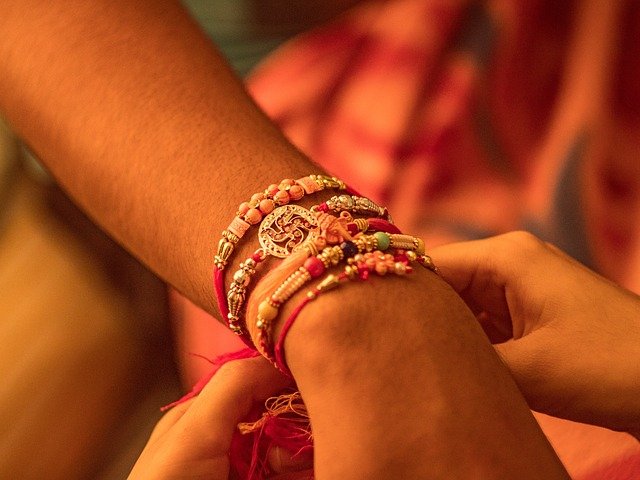basant-panchami

Why is Saraswati Pooja done on Basant Panchami
Come Basant Panchami and Nature bursts into a golden sari. Signifying the onset of Spring, Basant Panchami or Vasant Panchami is a popular Hindu festival celebrated all over India. Basant Panchami is dedicated to the Goddess Saraswati. The Hindu deity of Knowledge and Learning, it is celebrated with a lot of vigour by Hindus across India and in Nepal.
When is Basant Panchami Celebrated?
As per the Hindu or Indian Calendar, Basant Panchami is observed on the fifth day of the shukla paksha (waxing phase of the moon) of the Magha (around January/February) month of the Indian calendar, on the day called 'Vasant Panchami'.
Other aspects which account for choosing of the day is on the basis of prevalence of Purvahna Kaal i.e. the period between sunrise and mid-day. So, when Panchami tithi prevails during Purvahna Kaal, then the celebrations of Vasant Panchami begin.
But in general, Basant Panchami or Vasant Panchami falls around late January or early February every year.
The significance of Saraswati Pooja on Basant Panchami:
Every Basant Panchami, Goddess Saraswati -- the Goddess of Learning in Hindu Mythology, is worshipped in numerous homes across the country.
The reason why Basant Panchami is important is the association of this day to wisdom and learning. It is believed by many that Goddess Saraswati, the deity of wisdom, art, science, knowledge and music was born on this day. So, on this day devotees worship Maa Saraswati by performing Saraswati Puja, chanting Saraswati Mantra and visiting the temples of the Goddess.
Goddess Saraswati is believed to be the manifestation of creative energy and it is believed that those who worship her on this day are bestowed with knowledge and creativity. On the day of Vasant Panchami, Hindus read the Maa Saraswati Chalisa so that their future can be good.
In many regions, Saraswati temples are filled with elaborate feasts a night prior so that the Goddess can join in the celebrations and the festivities with her devotees the next morning.
As it is the day dedicated to the Goddess of Knowledge, some parents make it a point to sit with their children to make them study or write their first word and encourage learning. This significant ritual is referred to as Aksharabhyasam or Vidyarambham. In several educational institutions, the statue of Goddess Saraswati is adorned in yellow and then Saraswati Puja is performed where Saraswati Stotrams are recited by teachers and students alike to seek her blessings. Songs and poems on Basant Panchami are sung and recited on this day in many schools.
Basant Panchami and the colour yellow
A quite common sight on this auspicious occasion is women wearing bright yellow colours. As one can guess, yellow is strongly linked to the season spring. Yellow colour signifies peace and prosperity. It is a symbol of good health. It is also the main colour for Holi and Basant Panchami marks the beginning of a fresh season, so it is an auspicious colour.
Interestingly, it is also believed that Yellow is the favorite color of Saraswati Maa, so people wear yellow on this day and prepare yellow dishes and sweets
Additionally, it also marks the harvest time of the mustard crop and hence there is a special significance of the colour yellow. Not only are the women dressed in yellow attire and but the traditional sweets prepared are yellow in colour as well.
Traditions of Vasant Panchami
There are several traditions that are associated with a celebration of Basant Panchami. Different regions have different customs with which they observe this colorful festival.
Yellow rice and kheer are special food for this day. This is made in most households and offered to the gods.
Another important legend associated with this beautiful festival is the story of Kama. Kam is known as the Hindu god of Love. His wife is Rati. According to legend, God Kamad was burnt to ashes by Lord Shiva for his wrongdoings. Consequently, his wife Rati had to undergo 40 days of strict penance to bring her husband, Lord Kama, back. It was on the auspicious occasion of Vasant Panchami that Lord Shiva finally gave in to her request and brought her husband back to life. In celebration of this beautiful love story, to this day, Lord Kama, the god of love, along with his wife Rati are worshipped by devotees in several parts of India.
Vasant Panchami also marks the beginning of the preparations of Holi and Holika Bonfire which occurs 40 days after this festival.
In Hindu Astrology, the day of Vasant Panchami is considered Abhuja making it auspicious to start any work. This is the reason many marriages take place on this day.
Basant Panchami is a burst of freshness and brings in everyone’s life new blossoms and the hope of a good harvest and fortunate year ahead.
बसंत पंचमी पर सरस्वती पूजा क्यों की जाती है
बसंत पंचमी में प्रकृति एक सुनहरी साड़ी में सज जाती है। बसंत पंचमी वसंत की शुरुआत का प्रतीक है । वसंत पंचमी पूरे भारत में मनाया जाने वाला एक लोकप्रिय हिंदू त्योहार है। बसंत पंचमी देवी सरस्वती को समर्पित है । ज्ञान और शिक्षा की हिंदू देवी का यह त्योहार पूरे भारत और नेपाल में हिंदुओं द्वारा बहुत जोर-शोर से मनाया जाता है ।
बसंत पंचमी कब मनाई जाती है?
हिंदू या भारतीय कैलेंडर के अनुसार, भारतीय पंचांग के माघ (जनवरी / फरवरी के आसपास) महीने के शुक्ल पक्ष (चंद्रमा का एपिलेशन चरण) के पांचवें दिन बसंत पंचमी मनाई जाती है, जिसे 'वसंत पंचमी' कहा जाता है।
अन्य पहलू जो दिन को चुनने के लिए होते हैं, वह पूर्वाहन काल के प्रचलन के आधार पर होता है, अर्थात सूर्योदय और मध्याह्न के बीच की अवधि। इसलिए, जब पंचमी तिथि पूर्वाहन काल के दौरान प्रबल होती है, तब वसंत पंचमी का उत्सव शुरू होता है ।
लेकिन सामान्य तौर पर, बसंत पंचमी या वसंत पंचमी हर साल जनवरी के अंत या फरवरी की शुरुआत में आती है।
बसंत पंचमी पर सरस्वती पूजा का महत्व:
हर बसंत पंचमी, देवी सरस्वती - हिंदू पौराणिक कथाओं में शिक्षा की देवी की देश भर में कई घरों में पूजा की जाती है ।
बसंत पंचमी क्यों महत्वपूर्ण है इसका कारण है इस दिन का संबंध जो ज्ञान और शिक्षा से है। कई लोगों का मानना है कि इस दिन विद्या, कला, विज्ञान, ज्ञान और संगीत की देवी सरस्वती का जन्म हुआ था। इसी कारण से इस दिन भक्त सरस्वती पूजा करके, सरस्वती मंत्र का जाप करके और देवी के मंदिरों में जाकर माँ सरस्वती की पूजा करते हैं ।
देवी सरस्वती को रचनात्मक ऊर्जा की अभिव्यक्ति माना जाता है और माना जाता है कि जो लोग इस दिन उनकी पूजा करते हैं उन्हें ज्ञान और रचनात्मकता प्रदान की जाती है। वसंत पंचमी के दिन, हिंदू लोग मां सरस्वती चालीसा पढ़ते हैं ताकि उनका भविष्य अच्छा हो सके।
कई क्षेत्रों में, सरस्वती मंदिर एक रात पहले विस्तृत दावतों से भरे होते हैं ताकि देवी अगली सुबह अपने भक्तों के साथ उत्सव और उत्सव में शामिल हो सकें।
जैसा कि यह ज्ञान की देवी को समर्पित दिन है, कुछ माता-पिता अपने बच्चों के साथ बैठकर उन्हें अपना पहला शब्द लिखने या सीखने के लिए प्रोत्साहित करते हैं । इस महत्वपूर्ण अनुष्ठान को अक्षराभ्यासम् या विद्यारम्भम कहा जाता है । कई शिक्षण संस्थानों में, देवी सरस्वती की प्रतिमा को पीले रंग में सजाया जाता है और फिर सरस्वती पूजा की जाती है, जहाँ शिक्षकों और छात्रों द्वारा सरस्वती स्तोत्र का पाठ किया जाता है। कई स्कूलों में इस दिन बसंत पंचमी पर गीत और कविताएँ गाए और सुनाए जाते हैं।
बसंत पंचमी और रंग पीला
इस शुभ अवसर पर चमकीले पीले रंग की पोशाक पहने महिलाएं एक बहुत ही सामान्य दृश्य हैं। जैसा कि अनुमान लगाया जा सकता है, पीले रंग का मौसम वसंत से दृढ़ता से जुड़ा हुआ है। पीला रंग शांति और समृद्धि का प्रतीक है। यह अच्छे स्वास्थ्य का प्रतीक है। यह होली का मुख्य रंग भी है और बसंत पंचमी एक नए सत्र की शुरुआत होती है, इसलिए यह एक शुभ रंग है
दिलचस्प बात यह है कि यह भी माना जाता है कि पीला सरस्वती मां का पसंदीदा रंग है, इसलिए लोग इस दिन पीला रंग पहनते हैं और पीले रंग की मिठाई तैयार करते हैं
इसके अतिरिक्त, यह सरसों की फसल के कटाई के समय को भी चिन्हित करता है और इसलिए इसमें पीले रंग का विशेष महत्व है। इतना ही नहीं, न केवल महिलाएं पीले रंग की पोशाक पहनती हैं बल्कि तैयार की जाने वाली पारंपरिक मिठाइयों के रंग भी पीले होते हैं। यह शुभ माना जाता है ।
वसंत पंचमी की परंपराएं
कई परंपराएं हैं जो बसंत पंचमी के उत्सव से जुड़ी हैं । विभिन्न क्षेत्रों में अलग-अलग रीति-रिवाज हैं जिनके साथ वे इस रंगीन त्योहार का पालन करते हैं।
पीले चावल और खीर इस दिन के लिए विशेष भोजन हैं। यह ज्यादातर घरों में बनाया जाता है और देवताओं को चढ़ाया जाता है ।
काम की कहानी इस खूबसूरत त्योहार से जुड़ी एक और महत्वपूर्ण कथा है। । काम को हिंदू देवता के रूप में जाना जाता है । उनकी पत्नी है रति। एक पौराणिक कथा के अनुसार , भगवान कामदेव को भगवान शिव ने उनके गलत कामों के कारण जला दिया था। नतीजतन, उनकी पत्नी रति को अपने पति, भगवान काम, को वापस लाने के लिए 40 दिनों की कठोर तपस्या से गुज़रना पड़ा। यह वसंत पंचमी के शुभ अवसर पर था जिस दिन भगवान शिव ने आखिरकार उनके अनुरोध को स्वीकार कर लिया और अपने पति को वापस जीवन में लाया। इस सुंदर प्रेम कहानी के उपलक्ष्य में, आज तक, प्रेम के देवता, भगवान काम, अपनी पत्नी रति के साथ भारत के कई हिस्सों में भक्तों द्वारा पूजा की जाती है।
वसंत पंचमी में होली और होलिका जलाने की तैयारी की शुरुआत भी होती है जो इस त्योहार के चालीस दिन बाद होती है।
हिंदू ज्योतिष में, वसंत पंचमी के दिन को अभिषेक (अभुजा )माना जाता है, जिससे किसी भी काम को शुरू करना शुभ होता है। । यही कारण है कि इस दिन कई शादियां होती हैं।
बसंत पंचमी ताजगी का संदेश है और सभी के जीवन में नई खुशियाँ और अच्छी फसल और आगे सौभाग्य की उम्मीद लेकर आती है। ।










